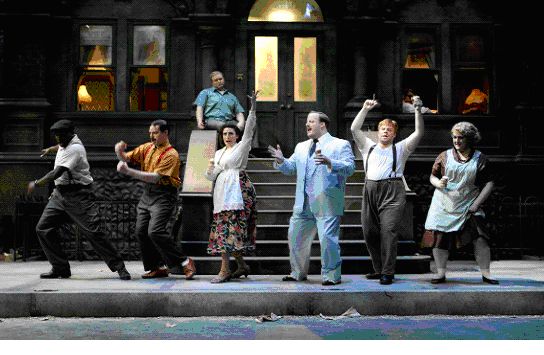 United States Kurt Weill, Street Scene: Soloists, Mark Gibson (musical direction), Steven Goldstein (stage direction), College-Conservatory of Music, Patricia Corbett Auditorium, University of Cincinnati, Cincinnati, OH. 15.11.12 (RDA)
United States Kurt Weill, Street Scene: Soloists, Mark Gibson (musical direction), Steven Goldstein (stage direction), College-Conservatory of Music, Patricia Corbett Auditorium, University of Cincinnati, Cincinnati, OH. 15.11.12 (RDA)

Shortly after his arrival in the United States in 1935 Kurt Weill plunged himself into the study of American popular and show music, and soon he was living and working with new American friends, among them playwright Elmer Rice, whose slice-of-life play Street Scene Weill had seen and admired. The composer approached Rice in 1936, but the author politely turned down the composer’s offer to write an American opera using his play as its libretto. Weill’s string of Broadway successes convinced the playwright, who agreed to the composer’s entreaties, and they then chose poet Langston Hughes as the lyricist for their collaboration.
Street Scene opened in New York at the Adelphi Theater in January of 1947 and ran for less than twenty weeks. Even its success with the critics could not keep the costly enterprise running, what with a cast of fifty singing actors and a larger-than-usual pit orchestra.
The ultimately tragic piece comes together in this dynamicproduction, presented by the Department of Opera of College-Conservatory of Music (University of Cincinnati), and vibrantly guided by the unfaltering hand of Steven Goldstein. His insightful stage direction consistently pries the young singers away from any hint of operatic posturing and keeps the multiple threads of the plot firmly in hand. His stage pictures are easy on the eye and logical to a fault, and his work with the young singing actors (many playing roles twice their age) is impeccable.
Mark Gibson’s fervent leadership in the pit infuses the ambitious score with both grandeur and earthiness and, when called for, a jaunty jazziness. Gibson is a true-blue opera conductor who whips his 32-strong student orchestra into a professional-quality ensemble, all the while keeping an eye on the stage, conducting with no score and giving his singers the necessary latitude to breathe and phrase in their own way.
Gibson and Goldstein get solid support from Brian Ruggabar’s impressively life-like three-story set, Abbi Squires spot-on costumes, Amy Whitaker authentic wigs and make up, David LaRose’s summery lighting and Danny Jama’s hyper-realistic sound design. Usually unsung heroes, the diction coaching of Rocco dal Vera and the musical preparation of Sylvia Plyler amply equipped the cast with authentic accents and stylish musicality.
The Conservatory’s Department of Opera, led by the indefatigable Robin Guarino, continues to impress with its adventurous programming. In addition to Street Scene, this year’s Kurt Weill Festival, generously supported by the Kurt Weill Foundation, includes lectures, master classes, cabarets, an upcoming production of Threepenny Opera, all done in collaboration with the school’s other departments.
Several of the principal roles in Street Scene are double-cast and most are assigned to graduate students, many of them young artists already making their mark in productions of the Cincinnati and Dayton opera companies. In Thursday night’s cast, soprano Summer Hassan (Anna Maurant) from sang a heart-rending “Somehow I Never Could Believe” and Marco. D. Cammarota (Sam Kaplan) spun out the hauntingly beautiful “Lonely House” in a plangent lyric tenor, later joining the lovely Meghan Tarkington (Rose Maurrant) in the rhapsodic “We’ll Go Away Together.”
Best among the best of the many ensemble moments were “Ain’t It Awful, The Heat?”and the hilarious “Ice Cream Sextet” – the latter led by the terrific Daniel Ross, abundantly dispensing vanilla ices along with plenty of Italian tenor antics. And when Catherine Helm and Josh S. Smith took the stage for “Moon-faced, Starry-eyed,” jazzing it up to the inventive choreography of Joey Dippel, the show was almost hijacked.
Weill’s quintessentially American Street Scene stands tall in the company of any of his other works for the stage, not to mention any of the many great American operas of his contemporaries—from either north or south of 42nd Street.
Rafael de Acha